Photonics companies are offering top dollar for entry-level jobs, if only people would take them.
John-Kevin Frazee put himself through community college while working for minimum wage at a grocery store. After graduating in 2011, he took jobs growing laser crystals and processing LED wafers. By age 23, he'd earned enough to buy a house.
"With our degree, I've never gone to a job interview and not been offered a job, so it's worked out pretty well for me," Frazee said.
That degree, from Central Carolina Community College in Lillington, N.C., designates Frazee an associate of applied science in laser and photonics technology.
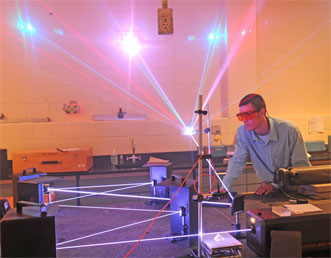
John-Kevin Frazee demonstrates how an argon-krypton laser can be used in light shows while a student in 2012. Courtesy of Central Carolina Community College.
Programs like the one Frazee completed give students a solid footing in optics concepts and practical skills for operating and maintaining lasers and electro-optical systems. While the programs are often tailored to the needs of companies in their regions, graduates often undergo a year or more of on-the-job training to become proficient.
About 30 community colleges around the U.S. produce approximately 300 photonics graduates annually — far short of the estimated 800 new technicians needed around the country each year. As a result, young technicians like Frazee tend to be highly sought after, which is remarkable in an economy where many recent college graduates struggle to find work.
The average starting salary for photonics technicians is $41,137 per year, based on a survey of 346 companies by the nonprofit National Center for Optics and Photonics Education, also called OP-TEC.
SPIE's 2015 Optics & Photonics Global Salary Report placed average pay for all photonics technicians — not just beginners — at $40,000, based on 242 survey results. For comparison, the average annual pay for electrical and electronics engineering technicians is $60,330, according to the most recent estimate from the U.S. Bureau of Labor Statistics.
Recent graduates who spoke with Photonics Media said they received from two to six job offers and took positions with starting pay, including overtime, ranging from $44,000 in the Midwest to $70,000 on the West Coast.
Executive Director Daniel Hull said starting salaries have likely increased since OP-TEC conducted its last survey in 2012.
"They probably are a little inflated," he said, "but they're going to stay that way another 10 to 15 years. I don't see demand going down."
Related: College Optics, Photonics Programs Are Lighting the Way
Building a supply chain
In Michigan, where manufacturing still dominates the economy, industrial lasers are seeing more and more use. That's creating demand for laser service technicians, said Mike Klos, general manager of Midwest operations for IPG Photonics Corp.
Seasoned technicians with the company can travel around the region and around the world, Klos said, and earn upwards of $100,000 a year. Even so, Klos wasn't optimistic about filling five current openings at IPG's lab in Novi, Mich. In past years he's had to look as far afield as Germany to find qualified people, so he's eager for nearby Baker College to start producing laser technicians.
With help from OP-TEC and funding from the National Science Foundation's Advanced Technological Education (ATE) program, Baker recently started an associate's degree program focused on photonics at its campus in Flint, Mich. About 10 students are enrolled, with half of them set to graduate in December, according to Anca Sala, dean of the college's engineering and computer technology department. Meanwhile, Mi-Light, Michigan's photonics cluster, recently awarded $1500 scholarships to two students entering the program.
"It will be really nice to hire kids who grew up in Michigan and don't want to go halfway around the world to get a job in photonics," Klos said.
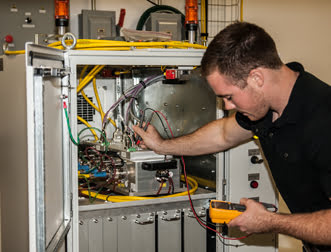
IPG Photonics technician Will Carlson verifies the alignment of a beam switch, a component that allows a laser to be operated by multiple robots or gantry systems. Courtesy of Juanita Garland/IPG.
Including Baker, there are more than 30 two- and four-year colleges in the U.S. with active photonics technology education programs, according to OP-TEC.
Five of those programs get curriculum input and other support from industry leaders like Joseph Coel, vice president of operations at Laserage Technology Corp. Based in Waukegan, Ill., the company performs contract manufacturing, cutting and welding. Coel started at the company in 1986 as a technician, later going back to school for a business degree.
Coel said he typically hires one to three technicians every year to keep up with business growth and promotions. But even with Indian Hills Community College and the College of Lake County relatively nearby, it can be difficult to find enough technicians — particularly if he needs them while school is still in session. Occasionally he's brought in computer-numerical-control technicians to set up laser equipment, a solution he called "mildly successful."
The problem of finding enough workers is exacerbated by some colleges abandoning photonics education. Coel's alma mater, Northcentral Technical College in Wisconsin, eventually ended its associate's degree program — primarily because graduates usually took jobs out of state, Coel said. The school still offers a certificate program for industrial laser operators, but Coel said an associate's degree is his "minimum prerequisite" for hiring a technician.
The financial landscape for community colleges is much different today than it was in the 1970s when many laser programs started, according to OP-TEC's Daniel Hull. With much less federal and state funding to rely on, colleges today are more inclined to cut programs with low enrollment. That's happening now at Indiana University of Pennsylvania, which Hull said has stopped accepting new photonics students.
Additionally, many photonics programs have only one instructor, meaning the programs sometimes disappear when those instructors retire.
When OP-TEC got its start in 2006, the number of colleges offering photonics programs had declined to 16 from a high of 40. Administering $1.3 million annually from the ATE program, OP-TEC helped restart 18 programs.
In addition to grants, OP-TEC provides teacher training and curriculum materials based on the electronics courses many schools already offer. Hull said OP-TEC has trained 80 instructors over the last eight years and has identified how to procure the necessary equipment for a photonics program for less than $200,000.
The OP-TEC model may be spreading. Officials at the University of Bordeaux in France are interested in starting a similar program for Europe. Hull gave a presentation there recently, and said the National Science Foundation has given its blessing for OP-TEC to work with the Europeans in an informal, advisory role.
Location, location, location
With a multitude of job offers, new photonics technicians often face the choice of whether to relocate after earning their degrees. Some gravitate to the East or West coasts, where technology companies and research institutions are concentrated. Some prefer to stay close to home.
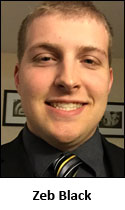 Zeb Black, 20, graduated in the spring from Indian Hills Community College in Ottumwa, Iowa. He said he had six job offers.
Zeb Black, 20, graduated in the spring from Indian Hills Community College in Ottumwa, Iowa. He said he had six job offers.
"I basically had to sit down and choose where I wanted to go, how much I wanted to make," he said.
The highest-paying position would have taken him to Denver, but Black settled on a job closer to home because of the lower cost of living. He works for RP Support America Inc. The company is based in New Sharon, Iowa, but Black frequently travels to New York and elsewhere to service the company's laser 3D printers, which are used for rapid prototyping.
Another Indian Hill graduate, Luka Papike, moved to Iowa for the laser program but wanted to get back to his native California to start a career. He took a job at the National Ignition Facility (NIF) at Lawrence Livermore National Laboratory, where 192 high-power lasers are combined to explore nuclear fusion.
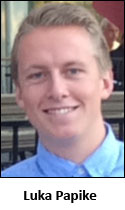 "You walk through the control room and it looks like you're at NASA," said Papike, 23. "It was very intimidating on the first day."
"You walk through the control room and it looks like you're at NASA," said Papike, 23. "It was very intimidating on the first day."
The NIF employs about 100 laser technicians and 20 to 40 optics processing technicians, according to Ron Darbee, superintendent of the facility's laser systems engineering and operations division.
Lawrence Livermore can find most of the electronics, mechanical and chemical technicians it needs in the Bay Area, Darbee said, but he searches nationwide for laser technicians. These employees can expect to more than double their $29-per-hour starting pay over the course of a career at the NIF, he said.
Still, keeping the positions filled is no easy task. The Bay Area is a very competitive job market, and technicians can be lured away. Meanwhile, Darbee said, more than half of his workforce will be eligible for retirement within the next five years.
"This is a prestigious organization," Darbee said. "It's got the world's most powerful laser. There's a lot to attract people. But we have to be out in the schools, talking to schools to get them to come."
Sparking interest
The schools struggle to get them to come, too.
Obstacles include the math and physics requirements of photonics programs and, for some, the stigma associated with attending a two-year college. And then there's the fact that photonics isn't exactly a household word.
"There are a lot of people out there that don't have any idea what it is," said Greg Kepner, chairman of the advanced manufacturing department at Indian Hills Community College. "We have a lot of work to do to get the word out and inform people."
That means giving eye-catching laser demonstrations at career fairs, high school math and science classes, even middle school assemblies and Boy Scouts meetings, according to Gary Beasley, lead instructor in the laser and photonics technology program at Central Carolina Community College (CCCC).
Formerly an engineer in the semiconductor industry, Beasley said he tries to give students as much hands-on and real-world experience as possible.
"I try to prepare students to be like the ones I liked to hire when I was out there," he said.
Demand for technicians is so high, Beasley said, that some companies have started students working before they've graduated. To accommodate their work schedules, Beasley started offering lectures online, requiring students to be on campus only on Fridays for lab exercises.
"Last year almost every student was working before they graduated," he said.
Shifting careers
Photonics technicians needn't all be twentysomethings fresh out of college.
Educators like Greg Kepner at Indian Hills Community College are exploring ways to provide photonics training to experienced workers from related fields.
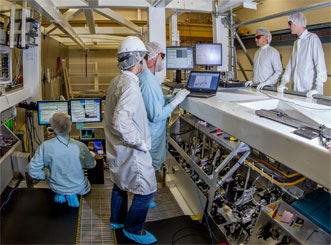
A group of technicians, engineers and scientists validate the performance of the High Contrast ARC Front End (HCAFE) AFECT (ARC Front End Compressor Table) system at the National Ignition Facility in Livermore, Calif. ARC stands for Advanced Radiographic Capability. Pictured from left to right are Tracy Budge, Matt Prantil, John Halpin, John Heebner and Tom Spinka. Courtesy of NIF.
The Midwest Photonics Education Center (MPEC), which Kepner directs, recently piloted a series of online and in-person training sessions with employees of Mound Laser & Photonics Center Inc., a materials processing and microfabrication company in Dayton, Ohio. The employees included a number of engineers and even a PhD who were skilled in working with delicate electronics but had no training specific to lasers, said former CEO Larry Dosser.
The pilot program was a success, and now Kepner is looking at ways to implement it on a larger scale. An MPEC survey found 24 companies around the Midwest interested in similar training, he said.
Meanwhile, OP-TEC is also exploring ways to provide training for technicians who will work at the recently announced national integrated photonics manufacturing center headquartered in Rochester, N.Y.
Dosser, who sold Mound two years ago, is now senior fellow for technology advancement at the Center for Manufacturing Sciences at Wright State University. In that role he's developing programs to get schoolchildren and college students interested in photonics.
MPEC was created last year to help other colleges in the region start or improve photonics-related course offerings. MPEC and another regional center headquartered at Indian River State College in Florida receive $750,000 per year from the ATE. Hull said he'd like to see a total of four regional centers supporting local programs around the country.
Workforce of tomorrow
OP-TEC's current three-year funding cycle is coming to an end and the organization is preparing to seek reauthorization from the ATE program. Hull said he hopes to secure about $900,000 per year for the next five years, which OP-TEC would spend on updating curriculum materials and boosting photonics enrollment at its partner colleges — particularly enrollment of women, minorities and veterans.
About 19 percent of the estimated 19,000 photonics technicians in the U.S. are female, according to OP-TEC's 2012 estimate. The group also found that about 18 percent of technicians are Asian, 14 percent are Hispanic and 4 percent are African-American.
Whatever their background, the rewards for photonics technicians are potentially great. Just ask John-Kevin Frazee.
A month before he graduated from CCCC, Frazee was under contract with Synoptics, a subsidiary of Northrop Grumman Corp. that makes materials and components for solid-state lasers in Charlotte, N.C. He worked there for about a year before being sidelined by an illness.
In 2013 he went back to work for LED manufacturer Cree Inc. in Durham, N.C., where he estimates he will make $75,000 to $85,000 including overtime this year.
As a process-sustaining technician, he works on a team of 19 in one of the company's wafer fabrication facilities. While his teammates have more advanced degrees, their background is primarily in electronics, making Frazee the optics expert of the group. The work is stimulating and offers daily opportunities to troubleshoot and think creatively, he said.
"It's nice having the two-year degree and being on the same level as people with bachelor's and master's [degrees]," Frazee said. "It really kind of gives us an advantage."